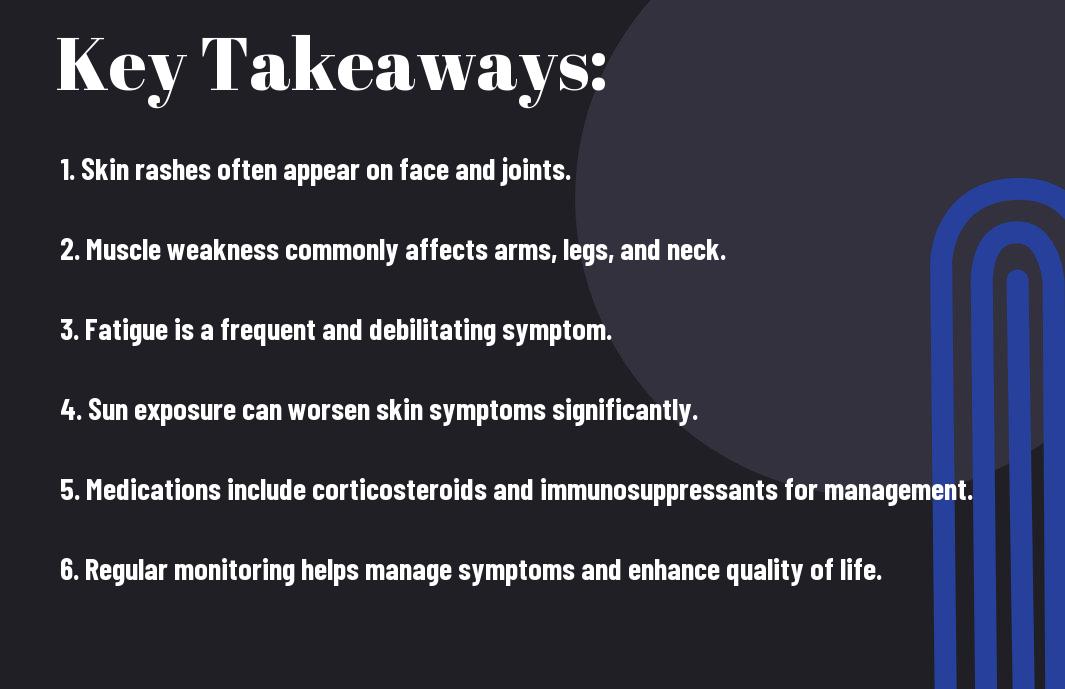With a complex array of symptoms, dermatomyositis can significantly impact your daily life. This rare autoimmune condition primarily affects your skin and muscles, leading to distinctive rashes and muscle weakness. Understanding the symptoms is vital for early diagnosis and effective management. In this blog post, we will explore the various signs of dermatomyositis and provide practical strategies to help you manage your condition effectively, empowering you to take control of your health and enhance your quality of life.

Understanding Dermatomyositis
For those seeking clarity on this rare autoimmune condition, understanding dermatomyositis is necessary. This disorder not only affects your muscles, leading to weakness, but also manifests through distinctive skin rashes. Being informed about these symptoms and management strategies can empower you to take charge of your health effectively.
What is Dermatomyositis?
By definition, dermatomyositis is an inflammatory disease characterized by muscle weakness and skin rashes. This condition affects people of all ages but is more common in adults, particularly females. The uniqueness of dermatomyositis lies in its combination of both muscle and skin symptoms, making timely diagnosis and treatment necessary for your well-being.
Causes and Risk Factors
By exploring the causes and risk factors of dermatomyositis, you can better navigate your health journey. This condition has been linked to various triggers, including:
- Genetic predisposition
- Environmental factors
- Autoimmune diseases
- Infections
Knowing these elements can help you understand your risk and engage in proactive measures to manage your health.
Causes contributing to dermatomyositis can often be complex. It's believed that a combination of genetic and environmental factors plays a significant role in its onset. Some potential triggers include:
- Exposure to certain medications
- Viruses and bacterial infections
- Sunlight exposure
- Smoking
Knowing your personal and family medical history can aid in identifying risk factors and prompt early intervention if necessary.
Recognizing Symptoms
Now that you are aware of dermatomyositis, recognizing the symptoms is crucial. You may experience a combination of skin changes and muscle weakness. For more detailed information, visit Dermatomyositis - Symptoms and Causes.
Skin Symptoms
Symptoms of dermatomyositis often include distinctive skin rashes, such as a violet or purplish rash on your eyelids or on the face. You may also notice a scaly, red rash on your knuckles, known as Gottron's papules, as well as patches on your chest and back.
Muscle Symptoms
Behind the skin symptoms, muscle involvement is another significant aspect of dermatomyositis. You may experience weakness in your muscles, particularly in those closest to your trunk, such as the hips and shoulders.
Symptoms can vary, but you might find it challenging to perform daily activities like climbing stairs, lifting objects, or standing up from a seated position. Muscle pain or tenderness may also accompany the weakness, making it crucial to consult your healthcare professional for an accurate diagnosis and appropriate management plan.
Diagnosis of Dermatomyositis
After experiencing symptoms indicative of dermatomyositis, it is necessary to seek a diagnosis from your healthcare provider. The clinician will typically review your medical history, conduct a physical examination, and consider potential symptoms specific to this condition. A timely diagnosis can help you begin appropriate management and improve your quality of life.
Diagnostic Tests
With a combination of blood tests, imaging studies, and possibly a muscle biopsy, your doctor can evaluate your condition more comprehensively. Blood tests often reveal elevated muscle enzymes, while imaging, such as MRI, provides insight into muscle inflammation. A biopsy of your muscle tissue can further confirm the diagnosis.
Differential Diagnosis
One of the challenges in diagnosing dermatomyositis is distinguishing it from other conditions with overlapping symptoms, such as polymyositis or lupus. Your healthcare provider will consider various factors to differentiate these disorders accurately.
Tests like electromyography (EMG) can assess the electrical activity in your muscles, helping to distinguish dermatomyositis from other myopathies. Additionally, your doctor may evaluate skin manifestations and rule out other conditions that could cause similar symptoms. This thorough approach is necessary to ensure you receive the most appropriate treatment plan tailored to your specific needs.
Treatment Options
Many individuals with dermatomyositis require a comprehensive treatment plan to manage symptoms effectively. This may include medications, physical therapy, and lifestyle changes tailored to your specific needs. Working closely with your healthcare provider will allow you to choose the right combination of treatments to reduce inflammation, improve muscle strength, and enhance your overall quality of life.
Medications
By following your doctor's recommendations, you can utilize a variety of medications to combat the symptoms of dermatomyositis. Corticosteroids, such as prednisone, are commonly prescribed to reduce inflammation. Other immunosuppressive drugs may also be included in your treatment plan to help prevent flare-ups and manage your immune response effectively.
Physical Therapy and Lifestyle Changes
Between medical treatments, physical therapy and lifestyle adjustments play an vital role in managing dermatomyositis symptoms. Engaging in regular, supervised physical therapy can help maintain muscle strength and flexibility. Additionally, adopting a balanced diet, managing stress, and getting adequate rest can further enhance your well-being.
And as you navigate your treatment journey, modifications to your daily routine can yield significant benefits. Incorporating gentle exercises, like yoga or swimming, may improve muscle endurance while minimizing strain. Making adjustments to your diet by including anti-inflammatory foods can support your immune system, and prioritizing sleep and stress management techniques can foster recovery. Together, these strategies can create a holistic approach to managing your condition and improving your quality of life.
Managing Symptoms
Keep track of your symptoms to effectively manage dermatomyositis. Utilize various treatments, such as corticosteroids and immunosuppressants, to help reduce inflammation and muscle weakness. For more detailed information, refer to Dermatomyositis - StatPearls. It's crucial to maintain regular communication with your healthcare provider for personalized strategies and adjustments to your treatment plan.
Coping Strategies
By developing healthy coping strategies, you can enhance your emotional well-being while managing dermatomyositis. Engage in relaxation techniques like deep breathing, meditation, or gentle yoga, which can alleviate stress and improve your overall quality of life. Make a schedule for your daily activities to create routine and stability.
Support Systems
At some point, you may find that having a strong support system is vital to managing your condition. Connecting with friends, family, and support groups provides not only emotional support but also practical advice from those who understand your experiences. Additionally, consider seeking out healthcare professionals who specialize in autoimmune diseases for further guidance.
The presence of a support system can significantly impact your journey with dermatomyositis. Offering a space to share experiences and emotions with others facing similar challenges helps alleviate feelings of isolation. Engaging in community support forums and groups can provide motivation, encouragement, and useful resources to help you navigate your daily life with this condition.

Living with Dermatomyositis
All aspects of life can be influenced by dermatomyositis, making it imperative to prioritize your overall well-being. You may need to adjust your daily routine to manage fatigue and discomfort, while also exploring treatment options to alleviate symptoms. Support from healthcare professionals, friends, and family can help you navigate this journey, allowing you to maintain your quality of life despite the challenges posed by the condition.
Long-term Outlook
Outlook for individuals living with dermatomyositis can vary, with some experiencing periods of remission while others may face ongoing symptoms. Engaging in regular check-ups and adhering to treatment plans can aid in managing the disease effectively. Staying informed about advancements in research and therapies is vital for optimizing your health and well-being.
Resources and Support Groups
By connecting with resources and support groups, you can find valuable information and emotional support tailored to your experience with dermatomyositis. These communities can provide you with insights into coping strategies, treatment options, and opportunities to connect with others who understand your journey.
Consequently, many organizations dedicated to autoimmune diseases offer forums, local chapters, and online resources specifically for dermatomyositis. Engaging with these platforms allows you to exchange experiences, gain knowledge, and foster friendships with fellow patients. Websites like the Myositis Association and local support networks can be invaluable in providing support and information tailored to your needs.
To wrap up
Drawing together the various symptoms of dermatomyositis, it's important for you to stay vigilant about skin changes, muscle strength, and any unusual feelings in your body. Early identification of symptoms can lead to effective management strategies, including medication, physical therapy, and lifestyle adjustments to enhance your quality of life. By staying informed and collaborating with your healthcare provider, you can effectively navigate the complexities of this condition and maintain your well-being.
FAQ
Q: What are the common symptoms of dermatomyositis?
A: Dermatomyositis is characterized by muscle weakness and skin rashes. Common symptoms include symmetrical muscle weakness, particularly around the hips, thighs, shoulders, and neck. Skin manifestations often include a distinctive rash, such as heliotrope rash (purple or violet discoloration) on the eyelids and a rash on the knuckles called Gottron's papules. Other symptoms may include fatigue, fever, and in some cases, lung involvement or gastrointestinal issues.
Q: How is dermatomyositis diagnosed?
A: Diagnosis of dermatomyositis involves a combination of clinical evaluation, laboratory tests, and imaging studies. Physicians generally analyze muscle strength and physical symptoms, conduct blood tests for specific enzymes (like creatine kinase), and check for autoantibodies. A muscle biopsy may be necessary to confirm inflammation or damage in muscle tissue. Dermatologic examination of skin rashes and MRI scans can further assist in the diagnosis.
Q: What treatment options are available for managing dermatomyositis symptoms?
A: Treatment focuses on managing symptoms and improving muscle strength. Corticosteroids, such as prednisone, are commonly prescribed to reduce inflammation. Immunosuppressive medications, such as azathioprine or methotrexate, can be used to control more severe cases. Physical therapy is also recommended to maintain muscle function and improve mobility. In some cases, intravenous immunoglobulin (IVIG) therapy may be considered for patients who do not respond to conventional treatments.
Q: Are there lifestyle changes that can help manage dermatomyositis symptoms?
A: Yes, several lifestyle changes can aid in managing dermatomyositis. Regular, gentle exercise tailored to individual abilities can improve muscle strength and overall health. A balanced diet rich in vitamins, minerals, and anti-inflammatory foods can support the immune system. It's also beneficial to protect the skin from sun exposure, as sunlight can exacerbate skin rashes. Adequate rest and effective stress management techniques may further enhance overall well-being.
Q: Can dermatomyositis affect anyone, and what are the risk factors?
A: Dermatomyositis can affect individuals of all ages, but it is more commonly diagnosed in adults between the ages of 40 and 60, as well as in children aged 5 to 15. Women are more frequently affected than men. Risk factors include certain genetic predispositions, previous infections, cancer, and some medications that may trigger symptoms. Individuals with autoimmune diseases may also have a higher risk of developing dermatomyositis.







0 Comments